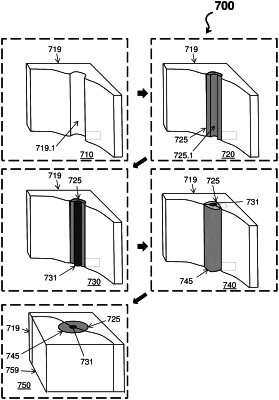| CPC B22F 7/08 (2013.01) [B22F 10/30 (2021.01); B33Y 10/00 (2014.12); B33Y 70/00 (2014.12); B33Y 80/00 (2014.12); B22F 10/25 (2021.01); B22F 2301/00 (2013.01); B22F 2301/052 (2013.01)] | 8 Claims |

|
1. A method of additive manufacturing, the method comprising,
depositing a first portion of a transition material in a first portion of a base material to form a first portion of a transition zone that defines a transition zone cavity;
disposing in the transition zone cavity an embedded electronic that extends from a bottom end to a top end to define a side surface;
after disposing the embedded electronic in the transition zone cavity depositing a second portion of the transition material on the first portion of the transition zone and on the embedded electronic such that the first and second portions of the transition zone encase the embedded electronic; and
after depositing the second portion of the transition material, depositing a second portion of the base material such that the first and second portions of the base material encase the transition material and the embedded electronic,
wherein the transition material directly contacts the side surface and covers the bottom end while completely encasing the side surface such that the base material does not directly contact the embedded electronic, and
wherein the transition material comprises an intermediate melting point that is lower than a melting point of the base material.
|